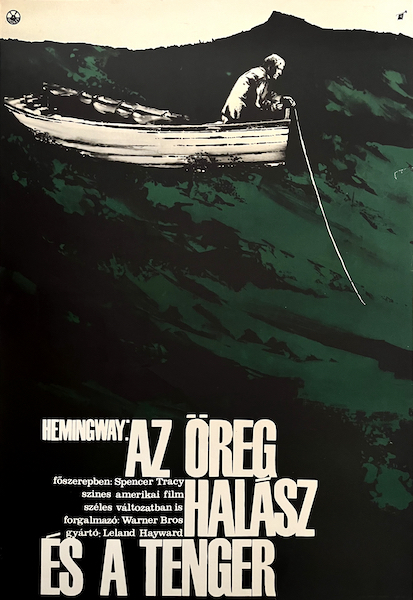
Description:
The Old Man and the Sea is a 1966 vintage Hungarian movie poster designed by Jozsef Finta for the film adaptation of the classic novel by Ernest Hemingway.
The Old Man and the Sea is a 1958 American adventure drama film directed by John Sturges and starring Spencer Tracy. The screenplay by Peter Viertel was based on the 1952 novella of the same name by Ernest Hemingway. Dimitri Tiomkin won the Academy Award for Best Original Score for his work on the film. The film was also nominated for Best Color Cinematography (Howe) and Best Actor (Tracy).
The Old Man in the film is a Cuban fisherman who has gone 84 days without a catch. His only friend is a 14-year-old boy named Manolin, who has been barred by his father from accompanying the Old Man out to sea. On the Old Man's 85th day out, he finally hooks a huge marlin, which he then tries to haul in from far out past shore. For three days and nights he battles the fish, which is portrayed in the film (as it had been in Hemingway's novella) as a trial of mental and physical courage that becomes the ultimate test for him of his worth as a man.
The Old Man and the Sea is a 1952 novella written by the American author Ernest Hemingway. Written between December 1950 and February 1951, it tells the story of Santiago, an aging fisherman who catches a giant marlin after a long struggle, but then loses his bounty to sharks. The novella was highly anticipated and was released to record sales; the initial critical reception was equally positive, but attitudes have varied significantly since then.
The last major fictional work to be published during Hemingway's lifetime, The Old Man and the Sea was begun in Cuba during a tumultuous period in the author's life. His previous novel Across the River and Into the Trees had met with negative reviews and, amid a breakdown in relations with his wife Mary, he had fallen in love with his muse Adriana Ivancich. Having completed one book of a planned "sea trilogy", Hemingway began to write as an addendum a story about an old man and a marlin that had originally been told to him fifteen years earlier. He wrote up to a thousand words a day, completing the 26,531-word manuscript in six weeks. Over the following year, Hemingway became increasingly convinced that the manuscript would stand on its own as a novella.
In May 1952, Life magazine published the full novella in its September 1st issue; Hemingway's publishers Scribner's released their first edition a week later on the 8th. Thanks to favourable early reviews and word-of-mouth, popular anticipation was so high that both releases were heavily bootlegged. The magazine sold a record 5.3 million copies in two days, while Scribner's sold tens of thousands of copies. Translated into nine languages by the end of 1952, The Old Man and the Sea remained on the New York Times bestseller list for twenty-six weeks. In 1953, it was awarded the Pulitzer Prize for Fiction, and it was the only work explicitly mentioned when Hemingway was awarded the Nobel Prize in Literature in 1954.
Early reviews were positive, with many hailing what they saw as a return to form for Hemingway after Across the River's negative reception. The acclaim lessened over time, as literary critics began to think the initial reception overblown and over-enthusiastic. Whether The Old Man and the Sea is inferior or equal to Hemingway's other works has since been the subject of scholarly debate. Thematic analysis has focused on Christian imagery and symbolism, on the similarity of the novella's themes to its predecessors in the Hemingway canon, and on the character of the fisherman Santiago.











